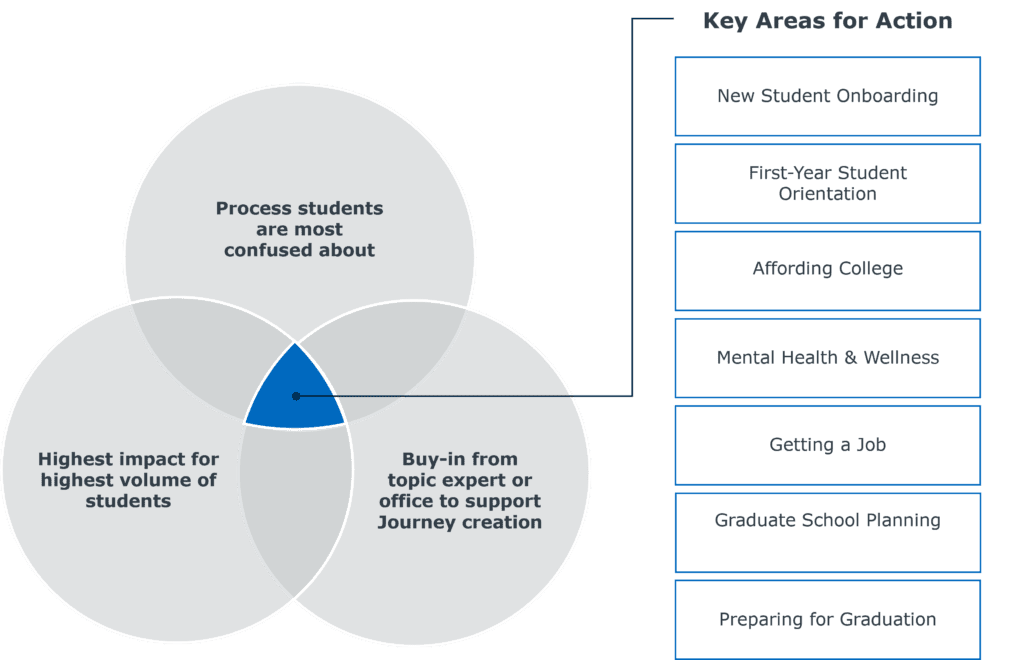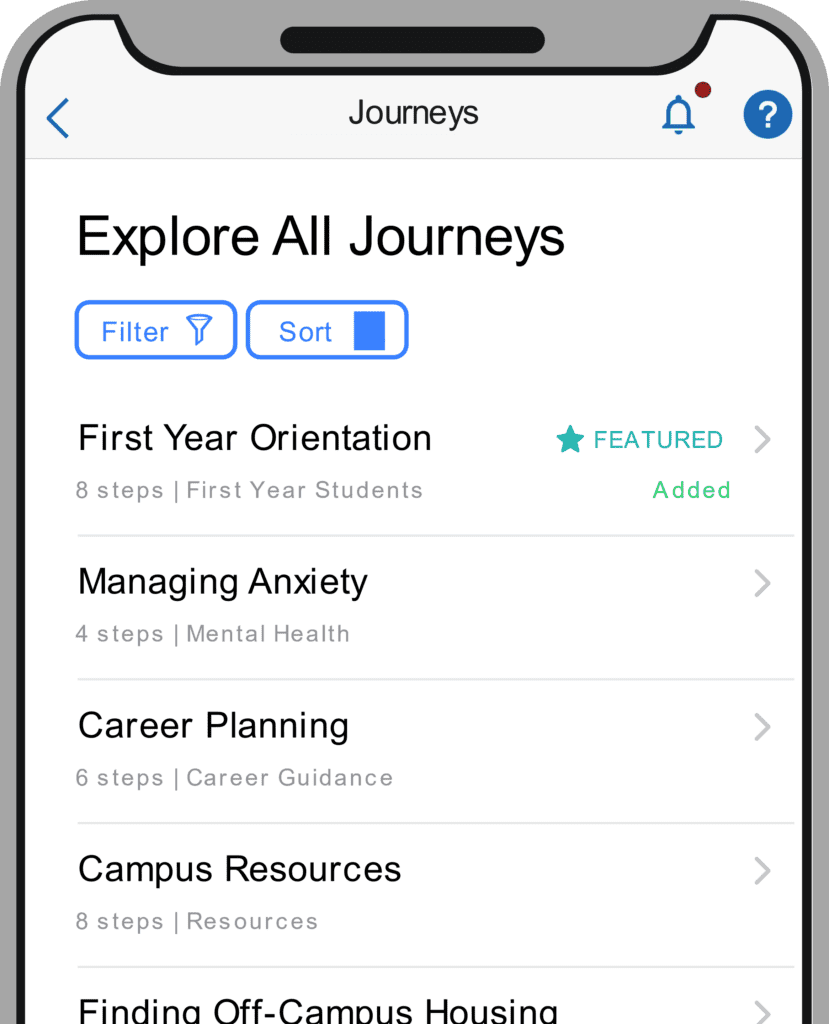4 steps to build better student support in higher ed
College doesn’t come with an instruction manual for students. Every decision students make along the way could impact their success. EAB’s Student Mental Health & College Readiness Report revealed that students often start college feeling anxious, and the ongoing decisions they face only add to their stress. Addressing these challenges early can set them up for success.
To help students succeed, institutions must provide structured and timely step-by-step guidance that supports them at every stage of their journey. Continue reading below for four steps that simplify processes for your students, drawing on best practices from peer institutions.
Step 1: Understand the role of step-by-step guidance in student retention
Institutions that have successfully improved retention rates often emphasize the importance of providing clear, actionable guidance right from the start. Most offer step-by-step guidance during onboarding or orientation, guiding students through essential tasks like accessing campus technology, meeting with advisors, and registering for courses. This structured approach helps incoming students navigate their first critical steps and sets the tone for their overall experience.
However, step-by-step guidance shouldn’t stop just as students begin their educational journey.
Students need guidance on a wide range of topics: how to afford tuition, manage their mental health, choose the right career path, and more. While there are no one-size-fits-all solutions to these challenges, institutions can guide students through these complex processes to make them much more manageable. By breaking down tasks like navigating financial aid into manageable steps, you help students focus on one task at a time, reducing the stress and confusion that leads to disengagement. This also fosters a sense of accomplishment, which is essential for maintaining student motivation and retention.
Learn More About the Six Drivers Shaping the Future of Student Success
Step 2: Identify which processes benefit most from step-by-step guidance
To truly maximize student support, institutions should simplify processes that target the areas where students need the most guidance. This involves focusing on three key factors:
- Processes that confuse students the most – Identify the processes students consistently struggle with, whether it’s navigating financial aid, registering for classes, or managing their mental health.
- Areas that have the highest impact on student retention – Focus on the processes that are most closely tied to student success and retention, ensuring that support is provided where it will have the greatest effect.
- A dedicated owner to manage student progress – Ensure there is a clear point of accountability, such as an assigned advisor or staff member, who can monitor and guide students through their journey.

By focusing on these critical areas, institutions can create more streamlined and effective student journeys that simplify processes, reduce confusion, and improve overall outcomes.
 Navigate360’s Journeys
Navigate360’s Journeys
This new Navigate360 feature helps students focus on proactive milestones critical to their college experience. Fully customizable, Journeys consist of steps tailored to your institution’s processes and can include text, links, images, videos, and other resources.
For Current Navigate360 Partners:
We’ve identified seven key journeys to help students reach their goals. Check out the ‘Journeys for Students’ starter pack here.
Step 3: Connect tasks to larger goals
Breaking down larger tasks into smaller, manageable steps tied to key milestones simplifies the student journey. By organizing guidance around specific phases, students can focus on tasks relevant to their current stage, making it easier to stay on track without feeling overwhelmed. This approach helps students navigate their academic path more effectively, tackling each phase of their college experience with greater confidence and clarity.
For example, let’s consider the critical stage of career preparation and job placement – a key part of the student journey that EAB’s research shows is a major value driver for students. When students clearly see how steps contribute to their larger goal of securing employment after graduation, they better understand the purpose behind each task. This understanding increases their motivation and likelihood of completion.
Step-by-Step Guidance to Help Students Secure Post-Graduation Employment
-
Take a Career Assessment
Guide students to use online career assessments to identify potential career paths based on their interests and strengths.
-
Research Career Pathways
Encourage students to explore job titles, read job descriptions, and research companies to find careers that align with their values and goals.
-
Create a LinkedIn Profile
Help students set up a professional LinkedIn profile and learn how to connect with industry professionals and potential employers.
-
Start Building a Network
Teach students how to network effectively by attending career fairs, connecting with alumni, and conducting informational interviews.
-
Complete a Job Simulation
Offer virtual job simulations where students can experience real-world tasks in their chosen fields, gaining skills and knowledge that enhance their employability.
-
Gain Practical Experience
Encourage students to build relevant experience through internships, student organizations, and volunteer opportunities that will make them more competitive in the job market.
Providing step-by-step guidance allows students to see the interconnectedness of various activities, understand their progress towards larger goals, and maintain motivation as they complete each step, ultimately leading to higher engagement and success rates in crucial aspects of their academic journey.
Watch this On-Demand Webinar to Better Understand the College and Career Disconnect
Step 4: Continuously monitor and adjust
Providing step-by-step guidance is just the start—simplifying processes for students requires ongoing monitoring and adjustment to ensure continued success. By tracking students’ progress, institutions can identify potential challenges early, whether it’s a drop in academic performance or disengagement, and step in with timely support. In Navigate360, advisors can assign specific journeys at key moments in a student’s college experience, keep track of what steps they’ve completed, and see where they might be struggling.
Regularly reviewing student data also helps institutions identify where processes could be further simplified. For example, if many students struggle with a particular course or step in the financial aid process, institutions should adjust and streamline these areas to make them easier to navigate. This constant refinement not only improves the student experience but also removes institutional barriers that could hinder student success.
Simplifying the Student Experience
Creating clear, step-by-step processes for your students creates a supportive environment where students feel confident and empowered to navigate their college journey. By understanding the role of step-by-step guidance in student retention, customizing support to fit your institution’s needs, and monitoring student progress, you can make a significant impact on student success. These steps not only help students manage the complexities of college life but also foster a sense of belonging and accomplishment that is critical to their persistence and completion.
Ready to learn how EAB can help your students reach their goals?
With over a decade of experience driving improvements in student success, we're here to help your institution with every step of the student journey. Fill out the form to connect with one of our experts and discover how Navigate360 can empower your students while streamlining your institution's success.

More Blogs

Four signs it’s time to break up with your student CRM

Three lessons from 1,200 student success leaders on higher ed’s future

 Navigate360’s Journeys
Navigate360’s Journeys